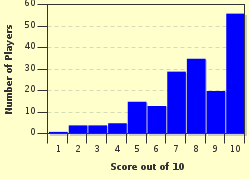Quiz Answer Key and Fun Facts
1. Which of the following is the name which came to be applied to the way of life set forth in the book?
2. Which of the following is a problem condemned repeatedly in the book, as something that leads to instability in the community?
3. A common event at monasteries was "lectio divina" (divine reading), the recitation of sections of Scripture or the writings of Church fathers. In what manner did Benedict recommend monks leave the room afterwards?
4. Every person in good health in a Benedictine community was expected to do which of the following?
5. What is an oblate?
6. St. Benedict required people to follow a routine in work and in religious observances. Which of these activities were done in the morning and evening, every day?
7. In what language was the first edition of the book printed?
8. In Chapter 56, who is to eat meals with the guests of the monastery?
9. As with people from any walk of life, monks too had to be on guard against the vices that beset human nature. Which of these actions is forbidden in Chapter 70 of the book?
10. Chapter 22 describes a number of details about life in the monastery. Which of these is a real item?
Source: Author
neon000
This quiz was reviewed by FunTrivia editor
agony before going online.
Any errors found in FunTrivia content are routinely corrected through our feedback system.

